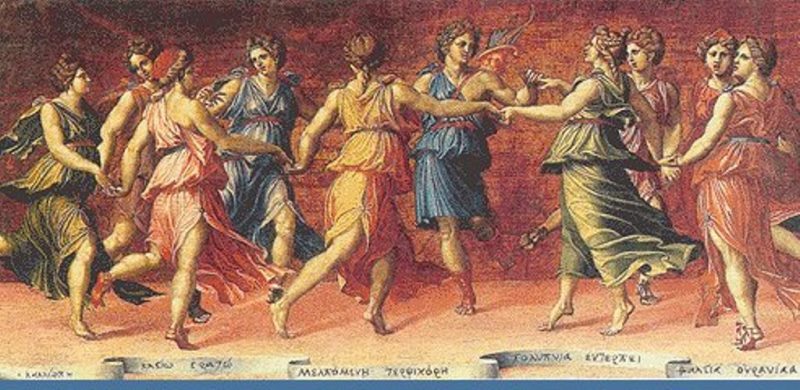
Jane and I are firm believers that if you get to know a little about the country in which the recipe you’re preparing comes from, it make the dish taste better 🙂 We love connecting with food while we’re cooking, and learning about the history of a country is one element we favor. That is why we write our “cultural post,” so we can share with you what we’ve learned and hopefully have you feel that connection we enjoy next time you’re cooking Greek food.
So, let’s turn our attention to Greek dancing! OPA!
Folk dancing has been a mainstay tradition in Greece since the ancient times. Greece is one of the few countries in which folk dancing is as popular today as it was at its inception. From the islands of Crete to Thrace, each region has their own unique folk dances, some more popular than others. This article will delve into the fascinating and rich history of Greek folk dancing.
Folk dancing is one of the most interesting aspects of Greece. This form of dancing has been around for thousands of years, and was typically used in correlation with song and music. The many iterations of folk dancing have been around since the dawn of the Greek civilization itself. The citizens of ancient Greece believed folk dances to be spiritual in nature. Plato himself wrote that “The dance, of all the arts, is the one that most influences the soul. Dancing is divine in its nature and is the gift of the gods.” This form of thinking was held by many of the Greek people, and is one of the primary reasons why it’s still so popular today. In ancient times, dance was one of the main pillars of the nation’s educational system and was used to cultivate the talents within the children of Greece. Folk dances were most commonly held in lieu of grand and extravagant celebrations, and were also used in wartime preparations as a means to give soldiers the confidence they needed before going out to battle.
For example, The Hasapiko (χασάπικο), is a Greek folk dance that has its roots from Constantinople. It’s a dance that starts slow and speeds up and was invented by the Greek butchers guild! You can see a famous Greek acrtess, Jenny Karezi, dance to it in her movie, Jenny Jenny:
There are a wealth of folk dances that have retained their popularity up to this day. Though there are many forms of folk dancing, the two basic categories of which all dances derive from are the leaping dance and the trailing dance, also known as Syrtos. Both of these dances are open circle. Syrtos is known as the oldest form of folk dancing, yet is also the most popular today. Leaping dances tend to be the livelier and more rugged of the two, while the Syrtos is meant to be a more serene and peaceful dance, though there are exceptions to this rule. One of the many appealing attributes of Greek folk dancing are the myriad of types. There are solo dances, male dances, female dances, and mixed dances, the latter of which was only recently accepted into the Greek culture. Each one of these has played an important role in the historical significance of Greece.
Syrtos is a name used to describe a vast collection of dances, typically line dances that form a semi-circle. Many regions in Greece have their own variation of the Syrtos dance, as each region has tailored it to match their own traditions. Today, the Syrtos dances are used in a number of Greek festivities and weddings. The most well known of these dances is the Kalamatianos, which uses the same steps as the Syrtos, though the former is more upbeat and faster paced. The Kalamatianos dance is one of the few Greek folk dances that is popular the world over and is commonly used in social gatherings and other festive occasions. It is also typically regarded as the national dance of Greece. The Kalamatianos dance is believed to have first appeared in the ancient writings of Homer, as it was referenced in the great poem of lliad. The name itself was derived from the town of Kalamata (where my family hails from!), which is located in Southern Greece. You can see people dancing this dance in the video below (yes, it’s a little dated, but you can see the traditional garments):
Leaping dances are used to categorize hopping dances that are very lively and energetic, many of them derived from the island of Crete in the ancient times. Long ago, men were the sole participants of the majority of these dances, though women are included much more often these days. The most popular of these is the Pentozali (πεντοζάλι) dance, which is a very exciting and vigorous dance. Though the Kalamatianos is said to be the national dance of Greece, the Pentozali rivals it in popularity. This specific form of Greek folk dance is known to have originated during the historical Turkish domination. It was created when the soldiers of Greece were preparing their fifth revolt against the Turkish empire. While the revolt ultimately failed, the dance lived on in the hearts of the Greeks.
As you can see, there is a vibrant history behind Greece’s love for dancing. While this only scratched the surface of this wonderful topic, we hope it will give you a general overview. There are so many dances, we just couldn’t cover them all. The next cultural post we do will be discussing the traditional garments the dances wear, so look out for that soon!! Plus, tasty new recipes of course 😉
PS. If you have anything interesting to add, please do so in the comment section below. We would love to hear your thoughts and or favorite memories about Greek dancing!



Hi Kenton & Jane,
Nice blog about Greek folk dancing… thanks for posting. A friend forwarded it to me. I come from the Greek city of Megara where the syrto & kalamatiano are quite popular. But you’ve mentioned my two favorite dances… the hasapiko and (a bit misspelled in your blog) the Cretan pentozali (πεντοζάλι). Another 2 quite popular dances are the syrtaki (συρτάκι) which is now probably the most widely-recognized of the Greek dances worldwide thanks to the movie “Zorba the Greek” and the hasaposerviko (χασαποσέρβικο) which you might recognize as having obvious Slavic (Serbian) roots as its name also suggests.
Best,
George
What do you know about the Karagouna?
Hey i really enjoyed your blog.It helped sooo much with my science projects on Greece dances.Good job! 🙂 😉 xD
HI! We are taking the kids to Greece this summer and I stopped by to read about the dances. We agree that knowing about the country makes the food better and would add it makes the adventure traveling there even more fun, too! We hope to get to see some of these dances in person!
Wonderful post, love the historical perspective